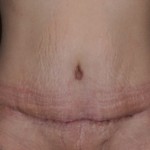
While a tummy tuck has the best chance for making one’s stomach flat, this does not mean that everyone will end up so. There are numerous factors which control how flat a stomach can become including one’s inherent body shape, the amount of intraperitoneal fat and the thickness of the upper abdominal skin flap. This last one, abdominal skin flap thickness, influences the chance of stomach flatness after a tummy tuck more than any other factor.
When a tummy tuck is done, a horizontal ellipse of skin and fat is taken from the lower abdomen. This newly created defect is eventually covered by the remaining upper abdominal skin being pulled down and stretched over it. This upper abdominal flap is composed of both skin and fat which moves downward through a combination of undermining and tissue stretch. The largest part of this tissue flap is composed of fat. Like an accordion, when the abdominal flap is pulled down to cover what was removed is does become less thick. The fat component of the flap, by necessity, must become thinner to cover a larger surface area.
The closure line of a tummy tuck brings together the upper abdominal skin flap and the inferior pubic skin flap. While in theory and in drawings the upper abdominal flap does all of the movement downward, this is not exactly so. There is some upper movement of the pubic area since it is not a fixed structure. Its skin and fat can stretch also. It simply does not move as much as it is smaller and more attached to the pubic bone and upper thigh area.

While some defatting of the lower edge of the abdominal skin flap may be done during surgery to prevent a shelfing deformity, it must be done conservatively to prevent devascularizing the skin edges and developing wound healing problems later. The same applies to thinning our the abdominal skin flap with liposuction.
The tummy tuck abdominal shelf deformity can be treated secondarily through either liposuction or skin flap resection. Liposuction can be used to thin out the thickness of the lower half of the lower abdominal skin flap. If the tummy tuck scar is thin and there is no loose skin above the incision, liposuction is the preferred treatment. If the tummy tuck scar is wide or otherwise not ideal and there is some amount of residual loose skin above the scar, then a wide scar revision approach would be better. Using a resection of the scar and an inch or two of skin and fat above it, a leveling of the two skin flaps across the new tummy tuck scar line can be achieved.
Dr. Barry Eppley
Indianapolis, Indiana


